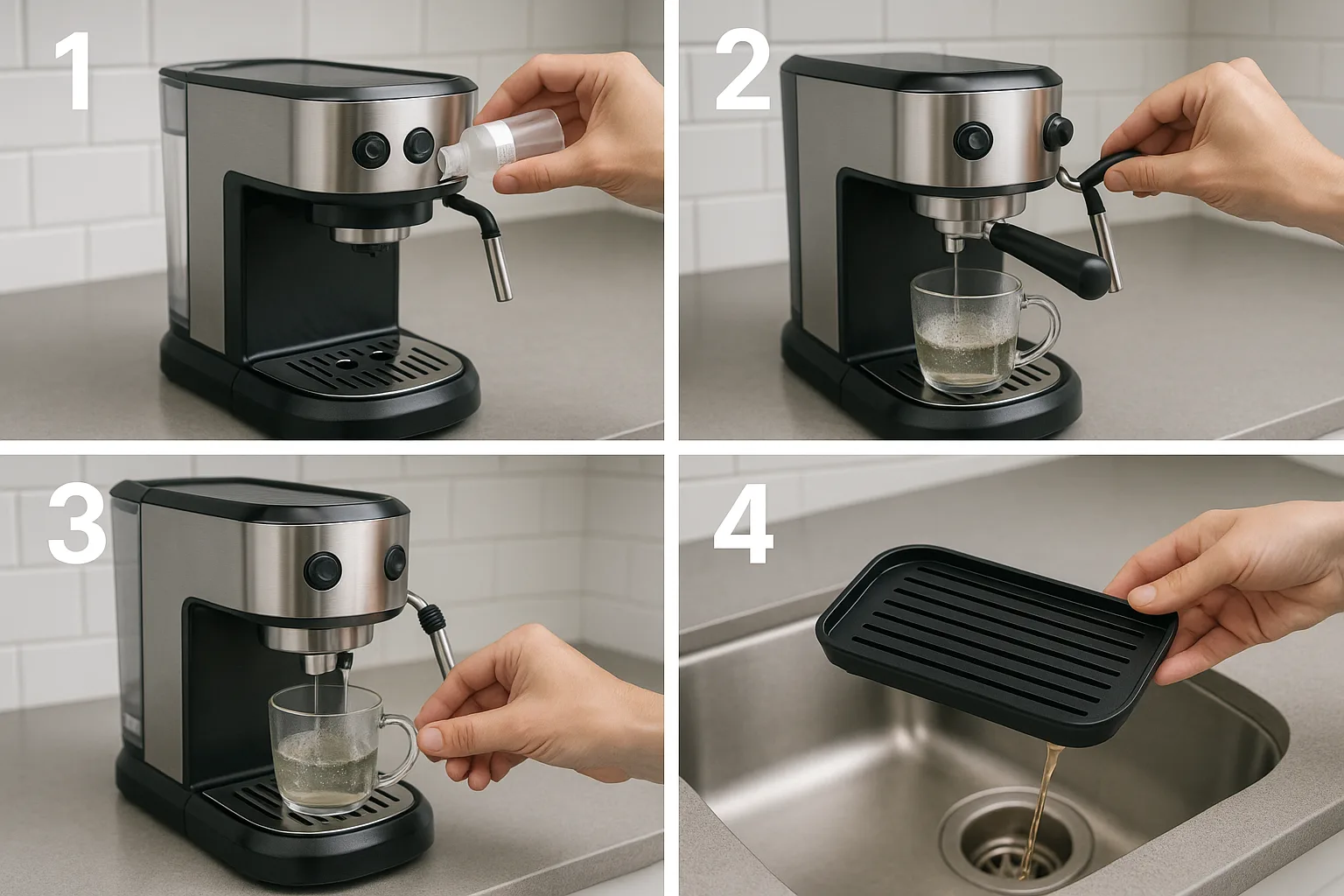Table of Contents
Picture this: you’re pulling your morning shot, and instead of that perfect golden crema, you get a weak, sour mess that barely resembles espresso. Your machine sounds like it’s struggling, the water flow is sluggish, and you’re wondering what went wrong. The culprit? Mineral buildup that’s slowly choking your beloved espresso machine to death.
Learning how to descale an espresso machine isn’t just maintenance—it’s the difference between café-quality shots and expensive disappointment. Every drop of water that passes through your machine leaves behind microscopic minerals that accumulate over time, creating scale that blocks water flow, reduces heating efficiency, and ruins your espresso’s flavor.
Key Takeaways
• Descaling frequency matters: Every 1-3 months depending on water hardness and usage frequency
• Use proper descaling solutions: Commercial descalers work better than DIY alternatives like vinegar
• Follow manufacturer instructions: Each machine has specific descaling procedures and solution ratios
• Regular descaling extends machine life: Prevents expensive repairs and maintains optimal brewing temperature
• Water quality impacts descaling needs: Hard water requires more frequent descaling than soft water
Why Descaling Your Espresso Machine Is Critical

Scale buildup is the silent killer of espresso machines. When minerals from water accumulate inside your machine’s boiler, heating elements, and internal pipes, they create a cascade of problems that affect everything from shot quality to machine longevity.
Temperature instability is the first casualty. Scale acts as insulation around heating elements, forcing them to work harder to reach proper brewing temperature. This leads to inconsistent extraction and off-flavors in your espresso. According to the Specialty Coffee Association’s brewing standards, maintaining precise water temperature is one of the most critical variables for achieving a balanced extraction..
Reduced water flow follows closely behind. Scale narrows internal passages, creating back-pressure that stresses pumps and reduces flow rate. Your shots will pull slower, and eventually, water flow may stop entirely. The pump works overtime trying to push water through blocked channels, leading to premature failure.
Flavor contamination is perhaps most noticeable to home baristas. Old mineral deposits create metallic, bitter tastes that overpower your carefully selected espresso beans. Even the best beans can’t overcome the harsh flavors from a scaled-up machine.
Regular descaling prevents these issues and keeps your investment running smoothly for years.
How to Descale an Espresso Machine: Step-by-Step Process
The descaling process varies slightly between manufacturers, but the core principles remain consistent across all espresso machines. Here’s the comprehensive method I use for most home espresso machines.
Preparation phase sets you up for success. Empty the water reservoir and drip tray completely. Remove the water filter if your machine uses one—descaling solution can damage carbon filters. Mix your descaling solution according to manufacturer specifications, typically one packet or measured amount per liter of water.
Solution circulation is where the real work happens. Fill the reservoir with descaling solution and initiate the descaling cycle. Most modern machines have dedicated descaling programs that automatically control water flow and timing. If your machine lacks this feature, manually run brewing cycles, allowing solution to flow through the group head and steam wand.
Contact time allows the descaler to break down mineral deposits. Let the solution sit in the system for 15-30 minutes between cycles. This dwell time is crucial—rushing the process leaves stubborn scale behind. I’ve found that patience during this phase dramatically improves descaling effectiveness.
Thorough rinsing removes all traces of descaling solution. Run at least three complete reservoir volumes of fresh water through the system. Taste the water coming from the group head—any chemical or sour taste means more rinsing is needed. Poor rinsing leaves residual flavors that contaminate your next espresso shots.
The entire process typically takes 45-90 minutes depending on your machine and scale severity.
Choosing the Right Descaling Solution and Frequency

Commercial descaling solutions outperform homemade alternatives in both effectiveness and safety. Brands like Dezcal, Durgol, and manufacturer-specific formulas are engineered to dissolve scale without damaging internal components. These solutions contain precise acid concentrations that break down minerals while protecting seals, gaskets, and metal surfaces.
Vinegar descaling remains popular among home baristas, but I recommend against it for several reasons. White vinegar’s acetic acid can damage rubber seals and leave persistent odors that affect espresso flavor. The acid concentration is also inconsistent, making it difficult to achieve thorough descaling without risking component damage.
Frequency depends on water hardness and usage patterns. Test your water hardness using strips or a TDS meter—this determines your descaling schedule more than any other factor. For a deeper understanding of how mineral composition affects your machine, Barista Hustle’s guide to water hardness explains exactly how temporary hardness converts into the scale that blocks your boiler.:
- Soft water (0-3 grains): Every 3 months with daily use
- Moderate hardness (4-7 grains): Every 2 months with daily use
- Hard water (8+ grains): Monthly with daily use
- Very hard water (12+ grains): Every 2-3 weeks with daily use
Adjust frequency based on usage—weekend-only machines can extend these intervals proportionally.
Machine-specific considerations matter for optimal results. Dual boiler espresso machines require descaling both boilers, often with separate procedures. Single boiler machines are simpler but may need longer contact time for thorough scale removal. Always consult your manual for manufacturer-recommended solutions and procedures—warranty coverage may depend on following official guidelines.
For home baristas serious about maintenance, I recommend keeping a descaling log. Track dates, water hardness, and any performance issues. This data helps optimize your descaling schedule and provides valuable information if warranty service becomes necessary. Proper maintenance records often expedite warranty claims and demonstrate responsible ownership to manufacturers.
Espresso Machine Descaling Schedule Calculator
Signs Your Espresso Machine Needs Immediate Descaling
Performance degradation often appears gradually, making it easy to miss until problems become severe. Slow water flow is typically the first warning sign—if your shots take significantly longer to pull or the steam wand produces weak pressure, scale buildup is likely restricting internal passages.
Temperature inconsistency manifests as erratic shot quality. Your espresso might taste sour one day and bitter the next, even with identical grind settings and espresso beans. This happens when scale prevents proper temperature regulation, causing wild swings in brewing temperature.
Unusual sounds indicate mechanical stress. Grinding, whining, or labored pump noises suggest your machine is working harder than normal to push water through scaled passages. These sounds often precede pump failure if descaling is delayed.
Visual indicators provide clear evidence of mineral buildup. White, chalky deposits around the group head, steam wand, or water reservoir outlet are obvious signs. Less obvious but equally important are metallic tastes in your espresso or visible particles in the water.
Machine error codes on newer espresso machines often indicate descaling needs. Many models monitor internal conditions and display warnings when descaling becomes necessary. Never ignore these alerts—they’re programmed based on manufacturer testing and real-world failure data.
Regular monitoring prevents these issues from reaching critical stages where expensive repairs become necessary.
Common Espresso Machine Descaling Mistakes to Avoid

Using incorrect solution ratios ranks among the most frequent errors home baristas make. Too weak, and scale remains; too strong, and you risk damaging internal components. Always follow manufacturer specifications exactly—these ratios are tested for effectiveness and safety.
Insufficient rinsing leaves chemical residues that contaminate espresso flavor and potentially damage your health. I’ve tasted machines that were poorly rinsed after descaling—the metallic, chemical taste is unmistakable and takes weeks to fully disappear. Run at least three full reservoir volumes of fresh water through the system.
Rushing the process undermines descaling effectiveness. Scale needs contact time to dissolve properly. Skipping dwell periods or running solution through too quickly leaves stubborn deposits behind. Plan for the full process time rather than trying to squeeze descaling into a busy morning.
Ignoring manufacturer guidelines can void warranties and cause damage. Each machine has specific procedures developed through extensive testing. Generic descaling advice might work, but manufacturer instructions are optimized for your specific model’s internal design and materials.
Descaling too frequently wastes money and potentially damages seals and gaskets. More isn’t always better—excessive descaling can degrade rubber components and create leaks. Stick to recommended schedules based on water hardness and usage patterns.
For home baristas looking to optimize their entire setup, proper descaling works hand-in-hand with other maintenance practices. Check out our guide to espresso machine accessories for tools that make maintenance easier and more effective.
Conclusion
Mastering how to descale an espresso machine transforms you from a casual coffee drinker into a true home barista who understands the critical relationship between maintenance and exceptional espresso. The 45-90 minutes you invest in proper descaling every few months protects your investment, ensures consistent shot quality, and prevents the frustration of declining performance.
Start by testing your water hardness today—this single measurement determines your entire descaling strategy. Create a maintenance schedule based on your specific conditions rather than guessing, and invest in quality commercial descaling solutions that protect your machine while effectively removing mineral buildup.
Remember that descaling is just one piece of the espresso excellence puzzle. Pair your newly maintained machine with properly selected espresso beans and continue developing your skills with our comprehensive barista guides. Your taste buds—and your espresso machine—will thank you for the attention to detail that separates exceptional home baristas from the rest.
Here is a helpful video tutorial on how to descale an espresso machine. It breaks down how to descale the Delonghi Magnifica S22.110.B.
I selected this video because it provides a clear, visual walkthrough of how to descale an espresso machine process on a popular home espresso machine, which perfectly complements the step-by-step text in your blog post.
Frequently Asked Questions
How often should I descale my espresso machine to keep it running smoothly?
For most home baristas, the general rule is every 1 to 3 months, but this relies heavily on your water hardness. If you have very hard water (8+ grains), you may need to do it monthly.
Understanding how to descale an espresso machine on a schedule appropriate for your water quality is the only way to prevent mineral buildup from damaging your heating elements.
Can I use white vinegar instead of a commercial descaling solution?
While vinegar is a common DIY hack, it is generally not recommended. Vinegar contains acetic acid which can eat away at internal rubber seals and gaskets, and it often leaves a lingering smell that ruins espresso flavor.
When learning how to descale an espresso machine safely, it is much better to use commercial products like Dezcal or Durgol, which are specifically formulated to dissolve scale without harming machine components.
What are the most common signs that my machine needs to be descaled immediately?
The most obvious signs are lukewarm coffee temperature, a significant reduction in water flow, or a machine that sounds like it is straining to pump.
If your shots are pulling slowly and tasting sour or metallic, those are red flags. Once you spot these symptoms, you should look up how to descale an espresso machine and perform the process immediately to avoid pump failure.
Why does my coffee taste like chemicals after I finished descaling?
This is a classic sign of insufficient rinsing. A crucial part of the process when you learn how to descale an espresso machine is the post-cleaning flush.
You must run at least three full reservoirs of fresh water through the group head and steam wand to ensure all acidic solution is removed. If you skip this, the chemical residue will contaminate your next few shots.
Is the descaling process different for single-boiler vs. dual-boiler machines?
Yes, the specific steps can vary. While the chemistry is the same, dual-boiler machines often require you to drain and fill both the brew boiler and the steam boiler separately.
To ensure you are doing it correctly, always check your specific manufacturer’s manual for instructions on how to descale an espresso machine for your specific model, as getting the procedure wrong can sometimes void your warranty.





Leave a Reply
You must be logged in to post a comment.